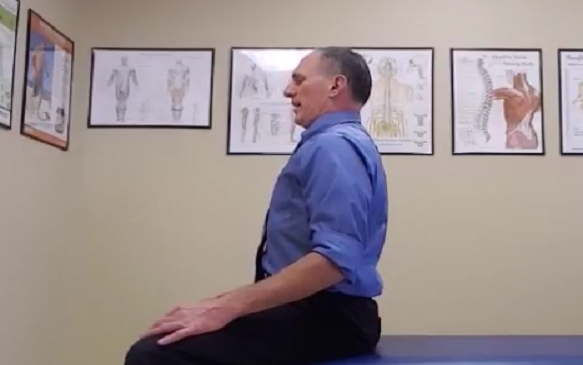Strengthen the upper back muscles, the posterior neck muscles and the muscles that retract the scapulae to improve your upper body posture. The upper back muscles that straighten the spine are the thoracic paraspinals. The muscles that retract the scapula are the rhomboid major, rhomboid minor, middle trapezius and lower trapezius. The deep cervical flexors help retract the cervical spine. Performing these exercises on a consistent basis to prevent and correct postural faults such as upper cross syndrome and scapular dyskinesis.
The thoracic spine is the medical name for the midback.
The cervical spine is the medical name for the neck.
The scapula is the medical name for the shoulder blade.
Thoracic Extension: Seated, Standing or Kneeling
Strengthen Thoracic Paraspinals.
Sit, stand or kneel in good posture.
Inhale and slowly flex thoracic spine through a symptom free range of motion.
Exhale and slowly extend thoracic spine through a symptom free range of motion.
Focus movement on thoracic spine and move one vertebra at a time.
Start with the number of repetitions that you can perform with proper technique and gradually increase to fifteen reps.
Assume a prone position. Forearms under chest. Chest contacting fists.
Inhale and slowly flex thoracic spine until chin almost touches floor.
Exhale and slowly extend thoracic spine through a symptom free range of motion.
Focus movement on thoracic spine and move one vertebra at a time.
Hold an isometric contraction for two to six seconds. Start with a two second hold and gradually progress to a six second hold.
Start with the number of repetitions that you can perform with proper technique and gradually increase to fifteen reps.
Isometric Scapular Retraction:
Strengthens scapular retractor muscles (Rhomboid Major, Rhomboid Minor, Middle Traps and Lower Traps.)
Stand, sit or kneel in good posture.
Hold neck in line with spine.
Pull scapulae (Shoulder Blades) toward each other.
Pinch the inner borders of your scapulae together.
Hold an isometric contraction for two to six seconds.
Hold an isometric contraction for two to six seconds. Start with a two second and gradually progress to six seconds.
Release the contraction and slowly return to the starting position by controlling the eccentric phase of the motion.
Start with the number of repetitions that you can perform with proper technique and gradually increase to fifteen reps.
Isometric Cervical Retraction:
Fundamental exercise that improves posture and lessens forward head carriage by strengthening the deep cervical flexors.
Sit, stand or kneel in good posture. Retract scapulae.
Maintain head in a neutral position, do not tilt head forward or backward.
Move head straight backwards.
Hold an isometric contraction for two to six seconds. Start with a two second and gradually progress to six seconds.
Build to fifteen repetitions of this isometrics exercise to strengthen the posterior neck muscles and correct poor posture.
Roll-ups: Improve strength, motion & upper body posture.
Combination of Seated Thoracic Extension, Scapular Retraction and Cervical Retraction.
Sit in good posture.
Flex cervical spine and thoracic spine by bending neck and midback forward as far as possible through a symptom free range of motion.
Extend thoracic spine one vertebra at a time by straighten the midback.
Retract inferior medial borders of scapulae by pulling lower corners of shoulder blades toward each other.
Retract cervical spine by moving the neck straight backwards.
Hold an isometric contraction for two to six seconds. Start with a two second and gradually progress to six seconds.
Release the contraction and slowly return to starting position by controlling eccentric phase of motion.
Start with the number of repetitions that you can perform with proper technique and gradually increase to fifteen reps.
Utilize these four fundamental exercises to increase upper body strength and improve upper body posture. Start at your current health and fitness level and increase the intensity in small, gradual calculated increments.
Disclaimer: Viewing this video does not take the place of seeing a medical professional, receiving proper training in the medical profession or working with a fitness professional. Please visit a medical professional for evaluation, diagnosis and treatment. Please work with a fitness professional to learn proper exercise technique and to develop a proper training program. Never perform an exercise that elicits or intensifies symptoms. If an exercise elicits or intensifies symptoms, stop immediately and use a viable substitute. Please receive proper medical training before attempting these medical procedures.
Dr Donald A Ozello DC of Championship Chiropractic in Las Vegas, NV
Web Site: http://www.championshipchiropractic.com/
Blog: https://www.championshipchiropractic.com/wordpress/
Twitter: https://twitter.com/drdozellodc
Facebook: https://www.facebook.com/Championship-Chiropractic-280141628688300/
LinkedIn: https://www.linkedin.com/in/dr-donald-a-ozello-dc-716b3233
YouTube: https://www.youtube.com/user/drdozellodc/videos
“Running: Maximize Performance & Minimize Injuries” https://www.amazon.com/Running-Performance-Chiropractors-Minimizing-Potential/dp/1493618741

